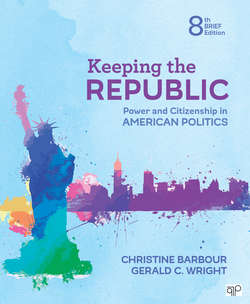Читать книгу Keeping the Republic - Christine Barbour - Страница 90
На сайте Литреса книга снята с продажи.
Amendability
ОглавлениеIf a constitution is a rule book, then its capacity to be changed over time is critical to its remaining a viable political document. A rigid constitution runs the risk of ceasing to seem legitimate to citizens who have no prospect of changing the rules according to shifting political realities and visions of the public good. A constitution that is too easily revised, on the other hand, can be seen as no more than a political tool in the hands of the strongest interests in society. A final feature of the U.S. Constitution that deserves mention in this chapter is its amendability—the founders’ provision for a method of amendment, or change, that allows the Constitution to grow and adapt to new circumstances. In fact, they provided for two methods: the formal amendment process outlined in the Constitution, and an informal process that results from the vagueness of the document and the evolution of the role of the courts (see Figure 2.2).
amendability the provision for the Constitution to be changed, so as to adapt to new circumstances
In the 200-plus years of the U.S. Constitution’s existence, more than 10,000 constitutional amendments have been introduced, but the Constitution has been amended only twenty-seven times. By contrast, in the course of interpreting the Constitution, the Supreme Court has, for example, extended many of the Bill of Rights protections to state citizens via the Fourteenth Amendment, permitted the national government to regulate business, prohibited child labor, and extended equal protection of the laws to women (see the next section for more on the Bill of Rights). In some cases, amendments previously introduced to accomplish these goals (such as the Child Labor Amendment and the Equal Rights Amendment) were not ratified, and in other cases the Court has simply decided to interpret the Constitution in a new way. Judicial interpretation is at times quite controversial. Many scholars and politicians believe that the literal word of the founders should be adhered to, whereas others claim that the founders could not have anticipated all the opportunities and pitfalls of modern life and that the Constitution should be considered a flexible, or “living,” document. We return to this controversy when we look more closely at the courts in Chapter 9.
The Constitution is silent on the subject of judicial interpretation, but in part because it is silent, especially in Article III, the courts have been able to create their own role. In contrast, Article V spells out in detail the rather confusing procedures for officially amending the Constitution. These procedures are federal—that is, they require the involvement and approval of the states as well as the national government. The procedures boil down to this: amendments may be proposed either by a two-thirds vote of the House and the Senate or when two-thirds of the states request it by a constitutional convention; they must be approved either by the legislatures of three-fourths of the states or by conventions of three-fourths of the states. Two interesting qualifications are contained in Article V: no amendment affecting slavery could be made before 1808, and no amendment can deprive a state of its equal vote in the Senate without that state’s consent. We can easily imagine the North-South and large state–small state conflicts that produced those compromises.
The constitutional convention method of amendment, where change is initiated by the states, has never actually been used, although states have frequently tried to initiate such a movement. In fact, an effort to create a balanced budget amendment in this way is currently in the works. Twenty-seven of the necessary thirty-four states (all Republican-led) have passed resolutions calling on Congress to hold a constitutional convention to pass a balanced budget amendment. Several other efforts are right behind it that would try to put in extra protections for religious freedom (and perhaps defining citizenship as beginning at conception) or limitations on government action. Opponents argue that once a convention is convened, it might be hard to contain the urge to make multiple changes to the Constitution, although three-quarter of the states would still need to approve the amendments.22
In Your Own Words
Explain the system of separation of powers and checks and balances.
